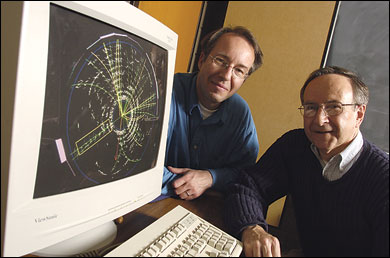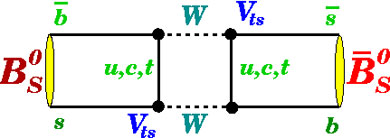|
|
||||
|
|
From Particle to Anti-Particle and Back Again: Carnegie Mellon Physicists Play Active Role in High-Precision Measurements
Professors Manfred Paulini and James Russ, members of the CDF collaboration, study a computer-generated representation of particle trajectories produced by proton/antiproton interactions in the CDF detector.
Carnegie Mellon professors Manfred Paulini and James Russ, together with graduate students Gavril Giurgiu and Vivek Tiwari, were part of a significant development in high-energy physics recently announced by Fermilab, a world-renowned particle physics laboratory near Chicago. The Collider Detector at Fermilab (CDF) collaboration, to which both professors belong, measured a matter-antimatter transition in a fundamental particle called a "B sub s" (Bs) meson. They found that Bs mesons turn into their anti-particles three trillion times every second, according to a press release issued by Fermilab April 11. The results were a collaborative effort of 70 students and scientists who performed the data analysis leading to the precision measurement.
"This is a landmark measurement that the high-energy community worldwide has been looking forward to for years. I'm very pleased that Carnegie Mellon has played an active role in the high profile analysis," said Fred Gilman, Buhl Professor of Theoretical Physics, head of the Department of Physics at Carnegie Mellon and former chair of the Department of Energy's High Energy Physics Advisory Panel.
Oscillations of Bs into its antiparticle (the bar over the Bs on the right).
"The interesting aspect of this strange dance between matter and anti-matter is that it completely follows the music of the Standard Model of particle physics," said Paulini. "Theories like Supersymmetry, which extend the Standard Model, would expect a much more rapid rhythm for the oscillations between Bs mesons than what our measurements revealed. The new CDF results show that the Standard Model is holding strong. This result constrains Supersymmetry in extending the Standard Model beyond its current foundation."
According to Paulini, the latest results also go a long way toward addressing CP violation, wherein subatomic particles appear to violate the symmetry of the laws of physics between particles and anti-particles. For more about CP violation and the ongoing work in high-energy physics at Carnegie Mellon, see www.cmu.edu/mcs/about-mcs/pdf/mcsnews2005-final.pdf.
April 17, 2006
|
||
|
Carnegie Mellon Home |
||||

